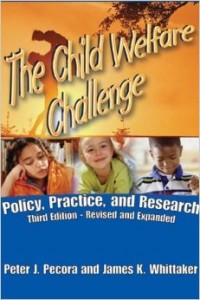Today’s guest blogger is Robin Johnson.
The following is a summarization from a chapter titled “Family Reunification and Kinship Care,” retrieved from The Child Welfare Challenge: Policy, Practice, and Research; written by Peter J. Pecora, James K. Whittaker, Anthony N. Maluccio, Richard P. Barth, and Diane DePanfilis, with Robert D. Plotnick (2009).
As the title suggests, the chapter information is twofold in that the authors highlight the importance of professionals in child welfare to examine the area of family reunification more thoughtfully, and if family reunification is not a possibility, then focus consideration on kinship care in permanency planning. I think the authors did a good job at promoting the idea of family reunification, prefacing that only if it protects the safety and wellbeing of the child. There are obvious situations and levels of severity that have caused children to be removed. So, careful assessment of this is necessary. I believe the chapter should have highlighted what this process should look like.
The positive aspect of family reunification clearly is that the family is reconnected. Although there was not much information about this in the chapter, and this is important to be aware of as well; research suggests, as children languish in the foster care system, there can be devastating effects on overall health, and development. Therefore, the sooner they can return home if possible, the better. With that being said, it is recommended that significant attention be paid to returning children to their families, in a timely manner. In order to do so, the authors suggest a competence based practice model which is guided by a perspective that emphasizes promoting family empowerment to enhance family functioning; building on the strengths of the parents, the family and other family members in this helping process, in addition to providing the necessary supports and services (Pecora et al. 2009).
Historically, services have focused around supporting the child; and as the chapter suggests, services must also focus on strengthening the parents, so they can support the return of their children. It is also suggested that current services don’t necessarily support the parent where they are at or address their specific problems, often putting unreasonable demands on parents because of their inability to understand processes. I do believe, if reunification is possible, and as the chapter suggests, supports need to be brief and intensive during the initial process of reunification and possibly long term support post reunification, is necessary to avoid reentry.
If reentry does occur, and reunification is not possible, the authors stress the importance of concurrent planning that includes the consideration for kinship care. Kinship care is other family such as grandparents, aunts or uncles, or other adults who can provide for the children when the biological parents cannot. Although the idea of kinship care should not be ruled out because the benefits of such include 1) allowance of the child to live with people they know or are familiar with, 2) reinforcement of the child’s sense of identity, and 3) facilitation of the child’s connections to siblings and family as a whole; I believe the chapter failed to discuss the concerns or pitfalls to kinship care.
Briefly, some scholars suggest, challenges in kinship care include 1) role and boundary confusion; assuming new roles, and relinquishing old roles can be difficult for the adult the child, and 2) the impact of family legacies; patterns of behavior, values and traditions that are passed on between generations- life cycles, and the need for kinship families to minimize such (Crumbley &Little 1997). Therefore, careful consideration and assessment of kinship is crucial to a child’s health and wellbeing, and other avenues to lifelong connections should be considered such as guardianship and adoption.
I know the article was specific to reunification and kinship care, however, I also feel it is important to identify what current steps or measures are being taken to prevent children from entering the system to begin with. I think this is a relevant area of concern, and requires immediate attention, to avoid family disruption and emotional upset to children and families as a whole. Pecora et al. (2009) state the challenge is such that the focus must be on preserving families and being mindful of the impact of separation and loss may have on children and parents. Therefore, Pecora et al. (2009) recommends new ways of thinking, informed policy changes, supportive programs, collaboration among service providers and systemic attention to developing competence of child welfare professionals.
References:
Crumbley, Joseph, and Robert L. Little (1997). Relatives Raising Children. An Overview of Kinship Care.
Peter J. Pecora, James K. Whittaker, Anthony N. Maluccio, Richard P. Barth, and Diane DePanfilis, with Robert D. Plotnick (2009). Family Reunification and Kinship Care retrieved from The Child Welfare Challenge: Policy, Practice, and Research.
